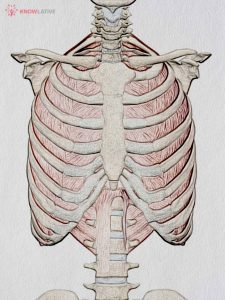There are eight muscles that make up and stabilize the thoracic cage:
- Intrinsic muscles:
- The intercostals: External Intercostals, Internal Intercostal (11 pairs each));
- Subcostals – Innermost Intercostals (12 pairs);
- Transversus Thoracis (1 pair).
- Diaphragm (1 muscle): the main breathing muscles that closes the thoracic cage at the base.
- Stabilizing muscles:
- Levatores Costarum (12 pairs): divided in Levatores Costarum Breves and Levatores Costarum Longi;
- Serratus Posterior Superior (1 pair);
- Serratus Posterior Inferior (1 pair).
These muscles act to change the volume of the thoracic cavity during respiration.
There are some difference in the description of these muscles in different authors:
- Some describe the presence, between external and internal intercostals, of a fourth muscle, the Middle or intermediate intercostal.
- Occasionally, a Supracostal muscle (musculus supracostalis anterior): from the anterior end of the first rib down to the second, third or fourth ribs. It is in continuation with the Abdominal External Oblique or Anterior Serratus.
There are differences also in the description of the role of these muscles in breathing. In classic descriptions the external intercostals are active in exhalation and internal (and middle) activate in inhalation. More recent studies suggest that the anterior portion of internal intercostals activates in inhalation. The other parts of internal intercostals and all other intercostals change their role according to the intercostal space they are and the position of the thorax.

